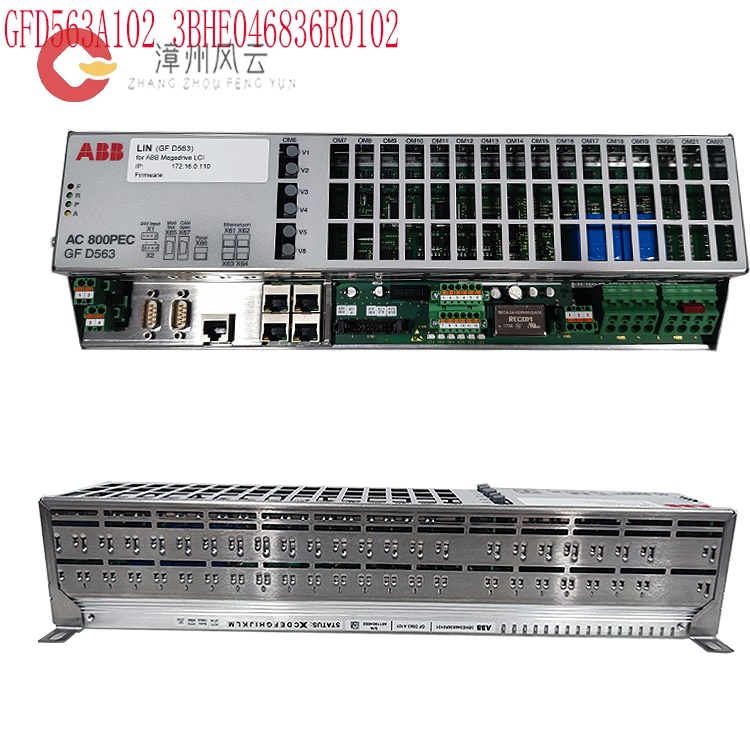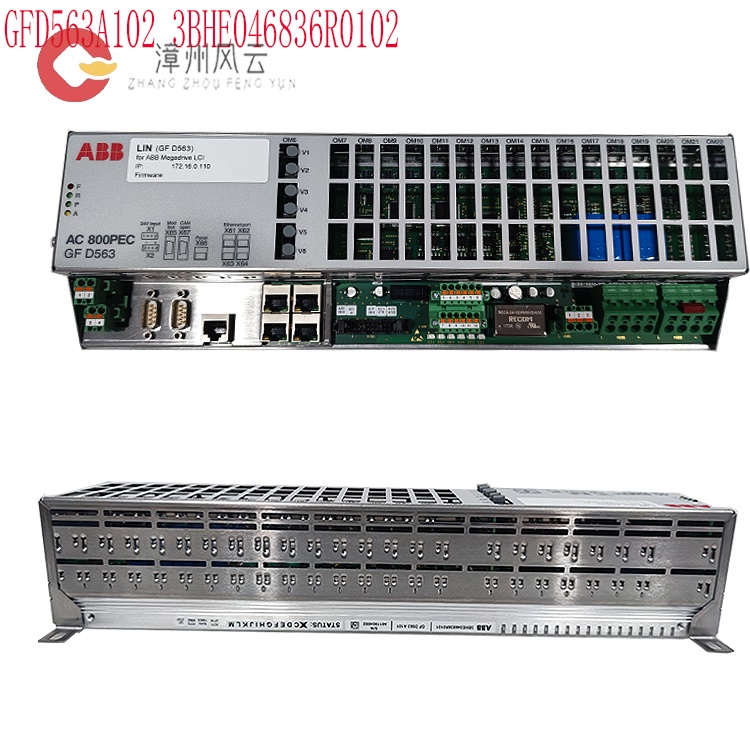
.jpg)
.jpg)

.jpg)
.jpg)
The excitation system central processing unit (CPU) is the core component of the excitation control system. It is responsible for real-time data processing, executing control algorithms, and outputting instructions to regulate the generator's excitation current, maintain voltage stability and system safety, and implement core functions such as automatic voltage regulation (AVR), power factor control, and reactive power control. It supports multiple control modes (such as constant voltage, constant power factor, and constant reactive power). As a global leading power and automation technology company, ABB's excitation system CPU unit is characterized by high reliability, high performance, and intelligence, and is widely used in hydropower, thermal power, nuclear power, and renewable energy power generation.
Many products are not yet available. Please contact us for more information.
If the product model number differs from the displayed image, the model number will prevail. Please contact us for specific product images, and we will arrange to take photos at the warehouse for verification.
We have 76 shared warehouses worldwide, so it may sometimes take several hours to accurately return your product. Please understand. We will, of course, respond to your inquiries as soon as possible.
GFD563A101 3BHE046836R0101 Other Names:
Excitation Analog Unit GFD563A101 3BHE046836R0101
GFD563A101 3BHE046836R0101 Editable Controller
GFD563A101 3BHE046836R0101 Input/Output Unit
GFD563A101 3BHE046836R0101 The excitation system central processing unit (CPU) is the core component of the excitation control system. It processes data in real time, executes control algorithms, and outputs commands to regulate the generator excitation current, maintain voltage stability, and maintain system safety. As a global leader in power and automation technology, ABB's excitation system CPU units are characterized by high reliability, high performance, and intelligence, and are widely used in hydropower, thermal power, nuclear power, and renewable energy generation.
.jpg)
Core Functions
Excitation Control Algorithm
Implements core functions such as automatic voltage regulation (AVR), power factor control, and reactive power control.
Supports multiple control modes (such as constant voltage, constant power factor, and constant reactive power).
Signal Processing and Protection
Collects signals such as generator voltage, current, and speed for real-time calculation and protection logic analysis.
Provides functions such as overexcitation, underexcitation, V/Hz limiting, and demagnetization protection.
Communication and Monitoring
Communicates with host computers (DCS, SCADA) via fieldbuses (such as Profibus, Modbus, and EtherCAT).
Supports local human-machine interface (HMI) or remote monitoring for parameter setting, fault diagnosis, and status display.
Redundant Design
Some models support dual CPU redundant configurations to enhance system reliability. An automatic switching mechanism ensures a disturbance-free transition during faults.
Voltage Regulation and Stability
A closed-loop control algorithm (such as PID control) adjusts the excitation current in real time based on generator terminal voltage or reactive power feedback, maintaining the output voltage within the set range (typically with an accuracy of ≤±0.5%).
Supports multiple control modes: Automatic Voltage Control (AVR), Constant Power Factor Control (PFC), and Constant Reactive Power Control (QCR).
Dynamic Response Optimization
Quickly responds to grid disturbances (such as sudden load changes and short-circuit faults) by preventing generator loss of step or voltage collapse through transient overexcitation/underexcitation limiting.
.jpg)
An integrated Power System Stabilizer (PSS) function suppresses low-frequency oscillations (0.1-2.5Hz) and improves grid stability.
Protection and Monitoring
Real-time monitoring of key excitation system parameters (such as rotor current, voltage, and temperature) provides protection against overcurrent, overvoltage, undervoltage, and demagnetization.
Supports fault recording and event logging for easy post-event analysis.
Communication and Integration
Provides multiple communication interfaces (such as Ethernet, Profibus, Modbus, and IEC 61850) for seamless integration with power plant DCS and SCADA systems.
Supports remote monitoring and parameter adjustment, enabling intelligent operation and maintenance.
Communication and Data Exchange
Integrates with power plant DCS and SCADA systems via Industrial Ethernet and fieldbuses (such as Profibus and Modbus) to enable remote monitoring and parameter adjustment.
Supports data logging and fault diagnosis for post-analysis and optimization.
Adaptive and Intelligent
Select models (such as the UNITROL® 6000 series) feature adaptive control, automatically adjusting control strategies based on grid frequency and voltage fluctuations.
Integrates artificial intelligence algorithms (such as neural networks) to optimize excitation response speed and stability.
Typical
Product Series
UNITROL® 6000 Series
Positioning: ABB's next-generation digital excitation system, suitable for large coal-fired, gas-fired, nuclear power, and pumped storage units.
CPU Features:
Adopts a dual-redundant processor architecture with hot standby switching and a reliability of 99.99%.
Integrated high-speed digital signal processor (DSP), with a control cycle of ≤10ms.
Supports adaptive control algorithms, dynamically adjusting control parameters based on unit operating status.
UNITROL® 5000 Series
Targeting: Excitation systems for medium and large units, widely used in hydropower, thermal power, and industrial drives.
CPU Features:
Single-processor architecture, high cost-effectiveness, with a control cycle of ≤20ms.
Supports mixed analog/digital inputs, compatible with upgrades to legacy excitation systems.
UNITROL® 1000 Series
Targeting: Excitation systems for small units or distributed generation (e.g., diesel generators and wind turbines).
CPU Features:
Compact design, high level of integration, and plug-and-play support.
Control cycle of ≤50ms, meeting basic excitation control needs.
Typical Application Scenarios
Coal-fired Power Plants
Controls steam turbine generator excitation to maintain grid voltage stability.
Works with AGC (Automatic Generation Control) to optimize reactive power.
Hydroelectric
Power Plants
Adapts to rapid changes in turbine load and provides dynamic excitation support.
Supports black start functionality (self-excitation without external power).
Renewable Energy
Excitation control of doubly-fed induction generators (DFIGs) in wind farms.
Excitation regulation of synchronous motors in energy storage systems.
Industrial Drives
Excitation of synchronous motors in large compressors and pumps to improve power factor and efficiency.
Installation and Commissioning
Mechanical Installation
Mount on a DIN rail or panel, ensuring adequate ventilation to prevent overheating.
Follow the spacing and grounding requirements in the ABB installation manual.
Electrical Wiring
Connect power, signal, and communication cables strictly according to the wiring diagram.
Use shielded cable to reduce electromagnetic interference (EMI).

Parameter Configuration
Use ABB's dedicated software (such as UNITROL Tool) to initialize parameters.
Set the control mode, protection thresholds, and communication parameters.
On-site Commissioning
Simulate generator operating conditions to verify excitation response speed and stability.
Test protection functions (such as overexcitation and V/Hz limiting) for reliable operation.
Maintenance and Troubleshooting
Daily
Maintenance
Regular Inspections: Confirm that the CPU operating indicators (such as "RUN" and "ALARM") are operating normally and that there are no abnormal alarms.
Firmware Upgrades: Update the CPU firmware according to ABB patches to fix potential vulnerabilities or optimize performance.
Environmental Monitoring: Ensure that the temperature and humidity inside the control cabinet are within the allowable range to prevent dust accumulation that may cause poor heat dissipation.
Common
Faults and Solutions
CPU Crash:
Symptom: All output signals are frozen, and the excitation current remains unchanged.
Solution: Restart the CPU (via the hardware reset button or remote command) and check whether the watchdog function is enabled.
Communication
Interruption:
Symptom: Data transmission with the DCS/SCADA system is abnormal.
Handling: Check the network cable/fiber connection, IP address configuration, and switch status, and restart the communication module.
Excessive
Control Deviation:
Symptom: The deviation between the generator terminal voltage and the set value exceeds the allowable range.
Handling: Calibrate the sensor signal, check whether the PID parameters are properly tuned, and re-tune if necessary.
Typical
Application Cases
Three Gorges Hydropower Station
Using the UNITROL® 6000 series excitation system with a dual-redundant CPU architecture and a control cycle of ≤8ms, it successfully copes with frequent unit starts and stops and severe grid load fluctuations.
Guangdong Taishan Nuclear Power Station
The excitation system CPU integrates the PSS2B algorithm, effectively suppressing 0.5Hz low-frequency oscillations and improving grid stability.
Inner Mongolia Wind Farm
Using the UNITROL® 1000 series excitation system, the CPU supports wind speed-excitation coordinated control, optimizing wind power grid connection quality.
A German nuclear power plant: Utilizing the UNITROL® 5000 redundant design, the plant passed rigorous safety certifications following the Fukushima nuclear accident, ensuring the reliability of its excitation system.
Spare Parts Management
Critical modules (such as CPUs and power modules) are kept in reserve to minimize downtime.
Regular firmware updates address known vulnerabilities.
Development
Trends
Intelligence: Integrates AI algorithms (such as neural network control) to achieve adaptive parameter tuning.
Network Security: Adds firewall and encrypted communication capabilities to protect against attacks on industrial control systems (ICS).
Modular Design: Supports hot-swappable CPU modules, shortening troubleshooting time.
Edge Computing: Implements some data analysis functions locally on the CPU, reducing the burden on upper-layer systems.
All products on this website are special
products, and market prices are constantly fluctuating.
Please refer to customer service for specific quotes. Since these products are new, prices may not be accurate.
Please confirm model, product, price, and other details with customer service before placing an order. This website is used.
New products are currently for sale. Please contact customer service for details.
Related
product recommendations:
PPD113B03-26-100110 3BHE023584R2634
PPD115A102 3BHE017628R0102
3BHE030410R3011 PPD117A3011
3BHE020455R0103 PPD103B103
3BHE040375R103E PPD512A10
3BHE040375R1023 PPD512A10
3BHE039724R0C3D PPD513AOC
8R37-2021-21-3101 PCD2000
3BHE022291R0101 PCD230A
3BHE057901R0101 PCD235C101
3BHE028915R0101 PCD237A101
3BHE041343R0102 PCD530A102
PPD113-B03-23-111615 3BHE023584R2365
PPD113B01 3BHE023784R1023
3BHE017628R0102 PPD115
More......
Address
Room 205, Office Building, No.1 Chaoyang North Road, Longwen District, Zhangzhou City, Fujian Province
fengyunfadacai@qq.com
Sales consultant
Miss.Green
+86 15860249102
